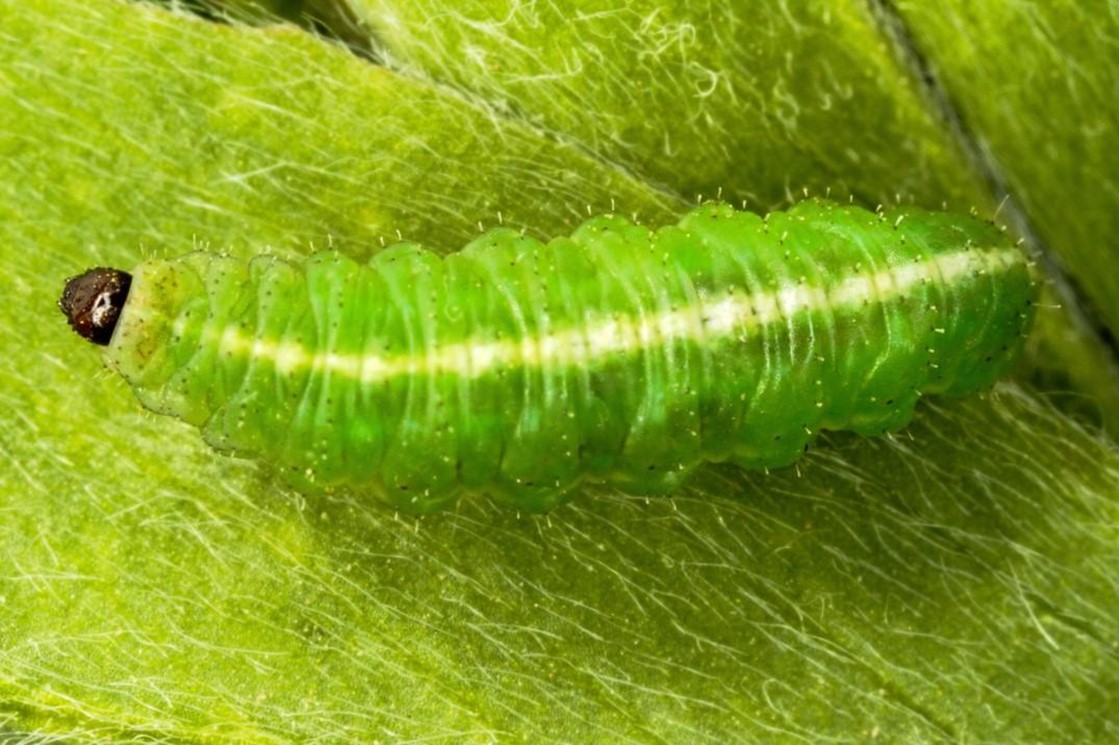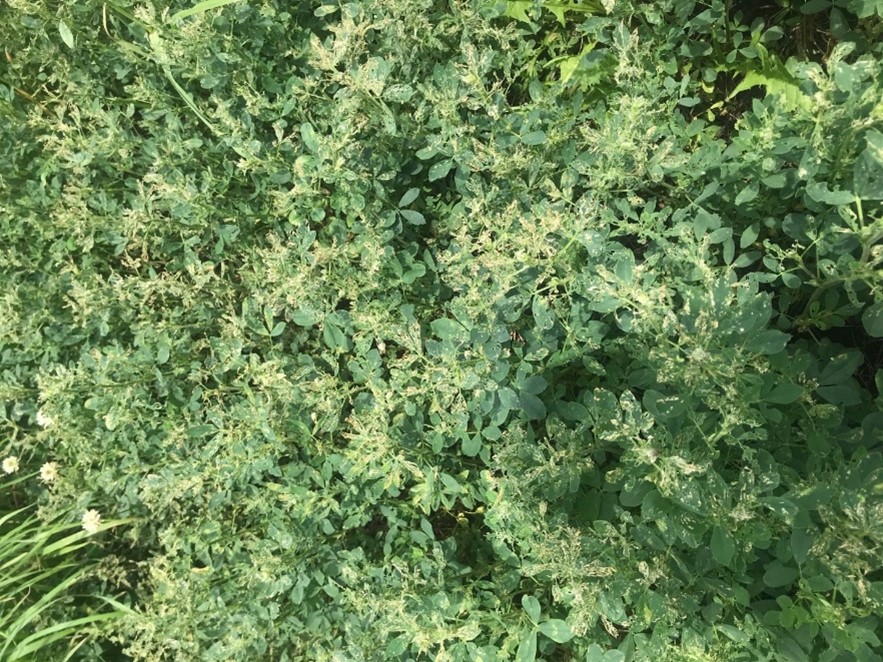- Alfalfa weevil can significantly damage the foliage of alfalfa
- Egg hatch and feeding has begun in Southern IL
- Use scouting information to determine if an insecticide or early harvest is needed as temperatures increase
Alfalfa weevils are an important pest affecting alfalfa production in many areas where the crop is grown. These insects feed on the foliage of alfalfa, reducing tonnage and quality (Figure 1). We have seen weevil activity in some areas, given the recent warming trend. This article discusses alfalfa weevil identification, scouting, and management.
Identification, Lifecycle, and Damage
Alfalfa weevils are small (1/4 in), brown beetles with an elongated, curved snout and readily fall to the ground when disturbed. A characteristic dark strip down the center of the back helps to distinguish this pest from other weevils that may be present in the field. After eggs hatch, small, light green larvae emerge, which have pronounced black heads and white stripes down the center and sides (Figure 2). These larvae are similar to the larvae of the less problematic Clover leaf weevil. The difference between the two is that the clover leaf weevil contains red smudges that border the central stripe. When mature and approximately 3/8 in length, larvae produce a white cocoon on foliage from which they will emerge as an adult weevil. Both the larvae and adults feed on alfalfa foliage, with larvae favoring feeding on the terminal and upper leaves, eventually skeletonizing leaves, and adults often feeding at leaf margins. If eggs were laid at significant numbers in the fall, the first cutting of alfalfa in warmer areas and in delayed harvested acres in cooler climates may be affected.

Scouting and Treatment Thresholds
Alfalfa fields in warmer regions and regions where feeding is predicted to begin should be monitored closely after egg hatch. If your area has experienced warmer than normal temperatures since February, your fields should be scouted immediately. Insects are cold-blooded, and their growth and development are driven by degree-day accumulation, similar to corn. Consequently, we can use knowledge of the GDD required for insects to estimate the approximate stage of development. For weevils, we are interested in knowing when eggs have hatched and larvae are active. Some states have insect degree-day calculators that can be used to help with scouting efforts. Illinois is one great example. If you live in Illinois, go to https://data.prairie.illinois.edu/warm_pdd/default.aspx and select the commodity crop, alfalfa weevil pest degree calendar for your location or the site closest to your area. Here is a universal link calculates alfalfa weevil GDD’s for states throughout Northeast, Southeast and Midwest: https://newa.cornell.edu/alfalfa-weevil/. Scout fields by making at least 20 stops across a field, using a “U” shaped path. At each stop, break off three stems by using the thumb and forefinger grip the stem (held horizontally) while allowing the middle finger to break the stem, then shake the stem into a bucket. Count the larvae and determine the average number of larvae per stem.
 The following are guideline thresholds for making an insecticide application: if stems are 3-7 inches tall, an average of 2 larvae per plant; 8-14 inches tall, 4 or more larvae per stem; late-season infestations-within 2 weeks of harvest early cutting is advisable. Ensure that label directions are followed and avoid the application of insecticides during bloom to avoid contacting honeybees and other pollinators. Regrowth should be carefully monitored for continued weevil activity to determine if stubble sprays are required. If 50% or more of regrowing crowns show signs of weevil damage and regrowth has been prevented for at least 3 days, an insecticide may be warranted. There are documented pyrethroid resistant populations of alfalfa weevil, so be sure utilize products with an effective mode of action. Contact your local FS Crop Specialist for more information.
The following are guideline thresholds for making an insecticide application: if stems are 3-7 inches tall, an average of 2 larvae per plant; 8-14 inches tall, 4 or more larvae per stem; late-season infestations-within 2 weeks of harvest early cutting is advisable. Ensure that label directions are followed and avoid the application of insecticides during bloom to avoid contacting honeybees and other pollinators. Regrowth should be carefully monitored for continued weevil activity to determine if stubble sprays are required. If 50% or more of regrowing crowns show signs of weevil damage and regrowth has been prevented for at least 3 days, an insecticide may be warranted. There are documented pyrethroid resistant populations of alfalfa weevil, so be sure utilize products with an effective mode of action. Contact your local FS Crop Specialist for more information.
References
Iowa State University-Alfalfa Weevils. https://crops.extension.iastate.edu/encyclopedia/alfalfa-weevil
Penn State University- Alfalfa Weevil. https://extension.psu.edu/alfalfa-weevil
University of Illinois. Alfalfa Weevil. http://extension.cropsciences.illinois.edu/fieldcrops/insects/alfalfa_weevil/
Related categories: pastures, insects, foliar feeders, alfalfa weevil